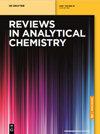基于6-氯- 2h -1,2,4-苯并噻吩二嗪-7-磺酰胺1,1-二氧化物有机分子探针的水溶液中UO2 +荧光猝灭检测
IF 3.8
3区 化学
Q2 CHEMISTRY, ANALYTICAL
引用次数: 0
摘要
一种新的有机分子探针作为一种“关闭”荧光传感器,用于检测几种过渡金属存在下的痕量UO2 +,并取得了令人满意的结果。该方法是基于在甲醇中不同浓度的UO2 +存在下猝灭6-氯- 2h -1,2,4-苯并噻二嗪-7-磺酰胺1,1-二氧化(L)的荧光强度。UO2 2+与L物质通过带负电荷的L磺酰胺基氮原子与带正电荷的UO2 2+之间的静电相互作用,促进了UO2 2+与L通过电荷转移或电子转移过程的非辐射重组,从而导致L的荧光猝灭。不同浓度UO2 - 2+对L荧光强度的猝灭作用已成功地作为一种新型传感器,在λ ex = 340 nm, λ em = 380 nm处测量甲醇中的UO2 - 2+,线性动态范围为0.08-5.0µM,检出限为0.0276µM,定量限为0.0837µM。与其他性能良好的传感器相比,L传感器显示出有趣的优势,如更宽的线性范围和更低的检测限,选择性和简单性,这说明了它的实用价值。基于6-氯- 2h -1,2,4-苯并噻吩二嗪-7-磺酰胺1,1-二氧化物有机分子探针的水溶液中UO2 +荧光猝灭检测。本文章由计算机程序翻译,如有差异,请以英文原文为准。
Fluorescence quenching detection of UO2 2+ in aqueous solution based on an organic molecule probe of 6-chloro-2H-1,2,4-benzothiadiazine-7-sulfonamide 1,1-dioxide
Abstract A new organic molecule probe has been introduced as a “turn-off” fluorescent sensor to detect trace quantities of UO2 2+ in the presence of several transition metals with promising results. The procedure is based on quenching the fluorescence intensity of 6-chloro-2H-1,2,4-benzothiadiazine-7-sulfonamide 1,1-dioxide (L) in the presence of various UO2 2+ concentrations in methanol. The UO2 2+ and L species interact through electrostatic interaction between negatively charged nitrogen atom of the sulfonamide group of L and positively charged UO2 2+, thus facilitating the non-radiative recombination of UO2 2+ and L through the charge transfer or electron transfer processes and leading to the fluorescence quenching of L. The mechanism of quenching was addressed and proved to be static quenching. The impressive quenching of the fluorescence intensity of L by different concentrations of UO2 2+ has been successfully used as a new sensor to measure UO2 2+ in methanol at λ ex = 340 nm, λ em = 380 nm with a linear dynamic range of 0.08–5.0 µM and detection limit and quantification limit of 0.0276 and 0.0837 µM, respectively. The L sensor shows interesting advantages compared to other developed sensors with adequate performance, such as broader linear range and lower detection limit, selectivity, and simplicity, which illustrate its useful practical use. Graphical abstract Fluorescence quenching detection of UO2 2+ in aqueous solution based on an organic molecule probe of 6-chloro-2H-1,2,4-benzothiadiazine-7-sulfonamide 1,1-dioxide.
求助全文
通过发布文献求助,成功后即可免费获取论文全文。
去求助
来源期刊

Reviews in Analytical Chemistry
化学-分析化学
CiteScore
7.50
自引率
0.00%
发文量
15
审稿时长
>12 weeks
期刊介绍:
Reviews in Analytical Chemistry publishes authoritative reviews by leading experts in the dynamic field of chemical analysis. The subjects can encompass all branches of modern analytical chemistry such as spectroscopy, chromatography, mass spectrometry, electrochemistry and trace analysis and their applications to areas such as environmental control, pharmaceutical industry, automation and other relevant areas. Review articles bring the expert up to date in a concise manner and provide researchers an overview of new techniques and methods.
 求助内容:
求助内容: 应助结果提醒方式:
应助结果提醒方式:


